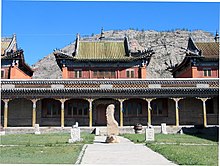Bugut Yazıtı
- Tür: Yazıt
- Kültür: Göktürk
- Yüzyıl: 6. yy
- Bölge: Moğolistan, Arhangay

The Bugut inscription (Mongolian: Бугут, romanized: Bugut) is a multi-lingual inscription first discovered in Ikh-Tamir sum of Arkhangai Province, Mongolia. The inscription is dated to 584 CE and was dedicated to Taspar Khagan (reigned 572–581) the fourth Khagan of the Turkic Khaganate. The inscription is in the form of a monumental wolf-crowned stele 198 cm high that sits on a turtle base 47 cm high. The front, right and left side of the stele has a Sogdian inscription written with Sogdian alphabet. The back side has a possibly Rouran inscription written with Brahmi script.[1] The original location of the inscription on the west bank of the Bayantsagaan river, a tributary of the North Tamir river, shows evidence of a walled complex. The wall embankment is 59mx30m with an inner moat 4.5m wide and 2m deep. In the center of the walled complex was a temple whose wooden pillars and roof tiles were still visible on the ground. Only a few brick fragments were found. The inscription itself was found within the walls on a square platform 7.5mx7.5m made of layered stones.[2]
- ^ Vovin, Alexander. "A Sketch of the Earliest Mongolic Languages: the Brahmi Bugut and Khuis Tolgoi Inscriptions". Academia.edu. Retrieved 6 July 2019.
- ^ "Монголын түүхийн тайлбар толь". mongoltoli.mn. Retrieved 6 July 2019.
